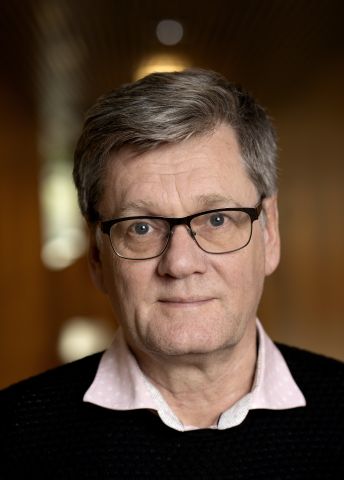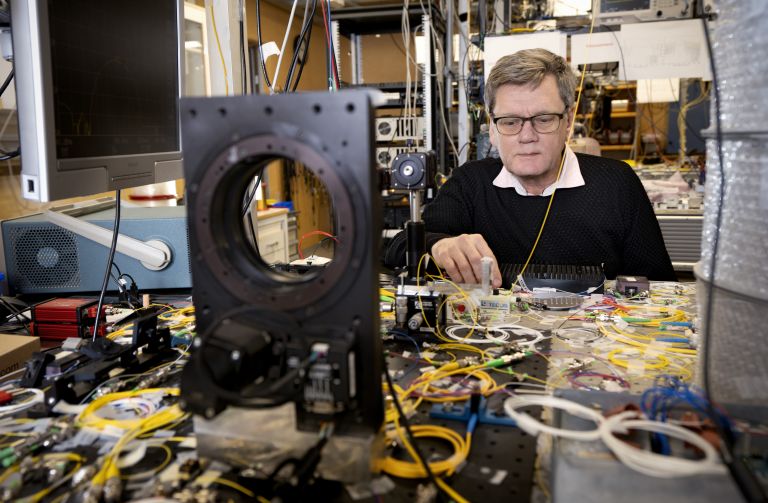
Peter Andrekson
Professor of Photonics
Wallenberg Scholar
Institution:
Chalmers University of Technology
Research field:
Fiber-optic communication


Wallenberg Scholar
Institution:
Chalmers University of Technology
Research field:
Fiber-optic communication
Andrekson’s research focuses on communication using light as an information carrier. As a professor of photonics at Chalmers University of Technology, he has established a leading research team in fiber-optic communication. Over the years, the team has developed new techniques to capture signals over both short and exceptionally long distances, with extreme speed and precision.
The group is now working to refine the technology and overcome the barriers in development of modern communication systems.
“Fiber-optic networks are everywhere, and are a basis for high-speed long-distance communication. They are fundamental to mobile telephony; they are the backbone of the internet; they are present in our power outlets and in data centers. But when information travels over long distances power gradually declines and the signals become weaker. Hence, optical amplifiers are needed to improve data transfer,” explains Andrekson.
Optical amplifiers are key components in many applications and research fields. The problem is that amplifiers generate disruptive optical noise that degrades the quality of information. Andrekson’s research team has worked on a solution by developing a noise-free optical amplifier that ensures error-free data transmission even when the signal is significantly weaker.
This phase-sensitive amplifier makes it possible to capture weaker signals without them being drowned in noise.
The technology is based on principles different from traditional optical amplifiers, utilizing a non-linear process that affects the phase of the light. Simply put, two different wavelengths of light interact to amplify the signal without adding extra noise.
“This phase-sensitive amplifier makes it possible to capture weaker signals without them being drowned in noise, transmit large amounts of data over longer distances at very high speeds, and reduce the power required for transmission,” he explains.
The team has spent over a decade developing and improving the amplifier, with the main aim of enhancing the capacity of fiber-optic systems. In recent years, they have also adapted the technology for use in free space. The key is a simplified transmitter combined with an ultra-sensitive receiver, which could eventually be used in communication links between space and Earth.
“We have managed to reduce the transmitter’s complexity while making the receiver more advanced. This makes the system particularly useful for space communication,” he says.
A major breakthrough is a new material platform for fabrication of the amplifiers – silicon nitride. It enables the researchers to reduce the size of the system using a compact solution: the hundreds of meters of optical fiber previously required by amplifiers are replaced by a chip only a few centimeters across.
“This platform enables us to produce chips with low losses and create optical amplification at many wavelengths across a very broad spectrum. The compact solution enhances the amplifier’s performance and makes it much more portable. And it can operate at room temperature, eliminating the need for complicated cooling systems. All of this is crucial for applications in space, such as laser-based communication to and from Mars,” he says.
In addition to space communication, the new platform paves the way for further applications, which the team plans to explore.
“The platform can replace many current amplifiers in applications where transmitting signals without them being drowned in noise is critical. One example is in quantum technology, where reducing disturbances is vital in order to extract quantum information from quantum computers,” he explains.
Andrekson also mentions that the increased bandwidth opens the door to more efficient telecommunications. Additionally, silicon nitride is transparent to visible wavelengths, which offers great advantages in microscopy and spectroscopy.
“We see synergies in several areas where it is crucial to eliminate unwanted noise. But we also want to explore applications that go beyond using the system for amplification. The chip can function as an ultrafast switch because it can be turned on and off very rapidly. This allows it to cope with and measure very fast processes, which is advantageous when developing measuring instruments. One example is detailed studies of different optical phenomena with very high temporal resolution,” he says.
Andrekson hopes to have made significant strides toward practical application within five years.
“We will be strengthening ties with potential collaborators and working to ensure that the system can be used reliably over time. Ultimately, my greatest wish is for the system to gain traction and provide real, practical benefits,” he says.
Research appeals to Andrekson for many reasons. One of them is the freedom to explore what feels exciting. Another is the opportunity to work alongside young, gifted researchers starting out on their scientific careers.
“When things start to come together in the lab, and you drop everything and stay until midnight... it’s an amazing feeling. It’s true that research often involves hard work. But it’s also a job that gives so much back,” he says.
Text Ulrika Ernström
Translation Maxwell Arding
Photo Johan Wingborg
Spectroscopy is the term used for numerous methods that use light (electromagnetic beams) or particle beams (neutrons, electrons, etc.) to examine materials, surfaces, atoms and atomic nuclei.